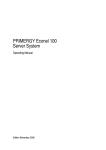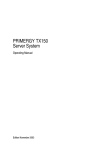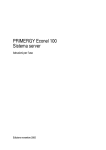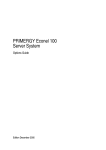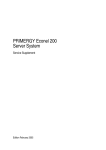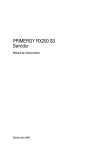Download vcaution! - Fujitsu manual server
Transcript
PRIMERGY PRIMERGY RX220 Server System Operating Manual Martin Jung Fujitsu Siemens Computers GmbH cognitas PS 81730 München e-mail: e-mail:[email protected] Tel.: (089) 61001-154 Fax: 0 700 / 372 00000 RX220 Sprachen: En Edition September 2005 Pfad: U:\RX220\rx220_ba\rx220_e.pdf\rx220us.vor © cognitas. Gesellschft für Technik-Dokumentation mbH 2005 Comments… Suggestions… Corrections… The User Documentation Department would like to know your opinion of this manual. Your feedback helps us optimize our documentation to suit your individual needs. Fax forms for sending us your comments are included in the back of the manual. There you will also find the addresses of the relevant User Documentation Department. Certified documentation according to DIN EN ISO 9001:2000 To ensure a consistently high quality standard and user-friendliness, this documentation was created to meet the regulations of a quality management system which complies with the requirements of the standard DIN EN ISO 9001:2000. cognitas. Gesellschaft für Technik-Dokumentation mbH www.cognitas.de Copyright and Trademarks Copyright © 2005 Fujitsu Siemens Computers GmbH. All rights reserved. Delivery subject to availability; right of technical modifications reserved. All hardware and software names used are trademarks of their respective manufacturers. Contents 1 1.1 1.2 1.3 1.4 Introduction . . . . . . . . . Overview of the Documentation Features . . . . . . . . . . . . Notational Conventions . . . . Technical Data . . . . . . . . . . . . . . 2 Installation Steps: Overview . . . . . . . . . . . . . . . . . 3 3.1 3.2 3.3 3.4 3.5 Important Notes . . . . . . . . Safety . . . . . . . . . . . . . . CE Certificate . . . . . . . . . . Transporting the Server . . . . . Notes on Installing into the Rack Environment Protection . . . . . . . . . . . . . . . . . . . . . . . . . . . . . . . . . . . . . . . . . 17 17 23 23 24 25 4 4.1 4.2 4.3 4.3.1 4.3.2 4.3.3 4.3.4 4.3.5 4.3.6 4.3.7 4.4 4.5 4.6 Hardware Installation . . . . . . . . . . . . . . . . Installation Steps . . . . . . . . . . . . . . . . . . . Unpacking the Server . . . . . . . . . . . . . . . . . Installing/Removing the Server into/from the Rack . . Requirements of the Rack . . . . . . . . . . . . . . . Necessary parts . . . . . . . . . . . . . . . . . . . . Preparing the Server . . . . . . . . . . . . . . . . . Mounting in the PRIMECENTER/DataCenter Rack . . Mounting into the Classic Rack . . . . . . . . . . . . Installing the Server . . . . . . . . . . . . . . . . . . Mounting in 3rd-Party Racks . . . . . . . . . . . . . Connecting Devices to the Server . . . . . . . . . . . Connecting the Server to the Mains . . . . . . . . . . Instructions on Connecting and Disconnecting Cables . . . . . . . . . . . . . . . . . . . . . . . . . . . . . . . . . . . . . . . . . . . . . . . . . . . . . . . . . . . . . . . . . . . . . . 27 28 28 29 30 33 33 34 36 37 38 39 40 41 5 5.1 5.1.1 5.1.2 5.2 5.3 5.3.1 5.3.2 5.3.3 5.4 Preparation for Use and Operation . . . . . . . . . . . . Operating and Indicator Elements . . . . . . . . . . . . . . The Front . . . . . . . . . . . . . . . . . . . . . . . . . . The Rear . . . . . . . . . . . . . . . . . . . . . . . . . . Switching the Server ON and OFF . . . . . . . . . . . . . Configuring the Server and Installing the Operating System Configuring the SATA RAID controller . . . . . . . . . . . . Configuration with ServerStart . . . . . . . . . . . . . . . Configuration without ServerStart . . . . . . . . . . . . . . Cleaning the Server . . . . . . . . . . . . . . . . . . . . . . . . . . . . . . . . . . . . . . . . . 43 43 43 47 48 51 51 52 52 53 RX220 . . . . . . . . . . . . . . . . . . . . . . Operating Manual . . . . . . . . . . . . . . . . . . . . . . . . . . . . . . . . . . . . . . . . . . . . . . . . . . . . . . . . . . . . . . . . . . . . . . . . . . . . . . . . . . . . . . . . . . . . . . . . . . . . . . . . . . . . . . . . . . . 5 . . 6 . . 8 . 12 . 12 15 Contents 6 6.1 Property and Data Protection . . . . . . . . . . . . . . . . . BIOS Setup Security Functions . . . . . . . . . . . . . . . . . 55 55 7 7.1 7.2 7.3 7.4 7.5 7.6 7.7 7.8 7.9 7.10 7.11 7.12 Troubleshooting and Tips . . . . . . . . . Power-ON Indicator Remains Dark . . . . . The Server Switches itself OFF . . . . . . . Screen Remains Blank . . . . . . . . . . . Flickering Stripes on the Monitor Screen . . No Screen Display or the Display Drifts . . . No Mouse Pointer Displayed on Screen . . . Floppy Disk Cannot be Read and/or Written Incorrect Time and/or Date . . . . . . . . . System Will Not Boot . . . . . . . . . . . . Drives Are Reported as "Dead" . . . . . . . Added Drive Reported Defective . . . . . . Error Messages on the Screen . . . . . . . . . . . . . . . . . . . . . . . . . . . . . . . . . . . . . . . . . . . . . . . . . . . . . . . . . . . . . . . . . . . . . . . . . . . . . . . . . . . . . . . . . . . . . . . . . . . . . . . . . . . . . . . . . . . . . . . . . . . . . . . . . . . . . . . . . 57 57 58 58 59 59 59 60 60 60 61 61 61 8 8.1 8.1.1 8.2 Hot-plug Components . . . . . . . . . . . Hot-plug Hard Disk Drives . . . . . . . . . . Handling Hard Disk Drives or HDD Modules Installing/Removing an HDD Module . . . . . . . . . . . . . . . . . . . . . . . . . . . . . . . . . . . . . . . . . . . . 63 63 64 65 Abbreviations . . . . . . . . . . . . . . . . . . . . . . . . . . . . . . . 69 Related Publications . . . . . . . . . . . . . . . . . . . . . . . . . . . 75 Index . . . . . . . . . . . . . . . . . . . . . . . . . . . . . . . . . . . . 77 Operating Manual RX220 1 Introduction The PRIMERGY RX220 server is a high performance AMD-based 2-way rack server which is characterized by an ultra compact design. The compact design (only 1HU high) fits perfectly into the data processing center and server farms. Within 19-inch infrastructures the server forms a flexible platform for sophisticated Web applications. It is suitable for use as e-mail server, terminal server and also as general application in multi-tier configurations. The PRIMERGY RX220 server offers a high level of reliability and availability through highly developed hardware and software components. Up to two AMD® Opteron™ processors, up to 16 GB ECC DDR-SDRAM main memory and max. two hot-plug hard disk drives fulfill highest requirements of functionality, performance and capacity. There are up two PCI extension slots: one PCI Express x8 and one 64-bit PCI-X. With its integrated SATA RAID controller the PRIMERGY RX220 system delivers maximum data security due to its hard-disk mirroring capability using Integrated Mirroring Enhanced (IME). In conjunction with ServerView and RemoteView, the onboard server management controller provides a comprehensive monitoring and remote management functionality. The optional RemoteView Service Board (RSB S2) enhances this functionality. Security functions in the BIOS Setup ("D2130 Setup Utility for RX220") and on the system board protect the data on the server against manipulation. Additional security is provided by the lockable rack door. RX220 Operating Manual 5 Overview of the Documentation 1.1 Introduction Overview of the Documentation I PRIMERGY manuals are available in PDF format on the ServerBooks CD. The ServerBooks CD is part of the ServerView Suite delivered with each server system. The PDF files for the manuals can also be downloaded free of charge from the Internet. The overview page showing the online documentation available on the Internet can be found via the URL: http://manuals.fujitsu-siemens.com (choose: industry standard servers). Concept and target group of this manual This operating manual describes how to install and how to operate your server. This manual is intended for those responsible for installing the hardware and ensuring that the system runs smoothly. The manual contains all the information required for installing and operating your PRIMERGY RX220. To understand the different expansion options, it is necessary to have a knowledge of hardware and data transmission, as well as basic knowledge of the operating system used. Additional server documentation To the PRIMERGY RX220 documentation set belong the following additional manuals: – "Quick Start Hardware - PRIMERGY RX220" (poster) – "Quick Start Software - PRIMERGY ServerView Suite" (poster) – "Warranty" manual (print version delivered together with the system, PDF file available on the ServerBooks CD) – "Safety" manual (print version delivered together with the system, PDF file available on the ServerBooks CD) – "Ergonomics" manual (PDF file available on the ServerBooks CD) – "Helpdesk" (poster with worldwide helpdesk telephone numbers) – Technical Manual for the system board D2130 (PDF file available on the ServerBooks CD) – "D2130 Setup Utility for RX220" manual (PDF file available on the ServerBooks CD) 6 Operating Manual RX220 Introduction Overview of the Documentation – "ServerView Suite" includes the ServerStart CD, the ServerBooks CD and the ServerSupport CDs. The PDF file of the user manual "PRIMERGY ServerView Suite - ServerStart" is also available on the ServerBooks CD. I If you need a backup of the ServerBooks CD, send the details of your server via email address: [email protected]. – "Global Array Manager Client Software User’s Guide" (PDF file available on the ServerBooks CD) – "Global Array Manager Server Software User’s Guide" (PDF file available on the ServerBooks CD) – "Integrated Mirroring User’s Guide" (PDF file available on the ServerBooks CD) – "RX220 Options Guide" (PDF file available on the ServerBooks CD) Further sources of information – – – – – – – technical Manual for the corresponding rack manual for the monitor manual for ServerView server management manual for the remote test and diagnostic system RemoteView documentation for the boards and drives operating system documentation information files of your operating system (see also “Related Publications” on page 75). RX220 Operating Manual 7 Features 1.2 Introduction Features System board The features of the system board (D2130) are described in the Technical Manual for the system board in relation to the hardware and in the "D2130 Setup Utility for RX220" (see “Related Publications” on page 75). Hard disk drives The server can accommodate up to two Serial ATA hard disk drive modules. It is also possible to connect external drives. Each hard disk drive module (also called "HDD module") can accommodate a SATA hard disk drive with a SATA interface and a maximum height of 1 inch. The module is connected to the SATA backplane without cables via the SATA interface. This allows hard disk drive modules to be simply plugged in or pulled out (for further details see section “Hot-plug Hard Disk Drives” on page 63). The internal hard disk drives are exclusively controlled by the onboard SATA RAID controller. Additional external drives are controlled by an optional PCI RAID controller card or via the USB interface. In a corresponding RAID configuration, the HDD modules can be exchanged during operation (hot-plug). SATA controller with IME functionality For operating internal hard disk drives, the SATA RAID controller with IME functionality is available (Integrated Mirroring Enhanced), offering RAID-0 and RAID 1 functionality for mirroring the internal disks. I To configure IME, the Promise FastBuild™ utility is available. For further information, see the corresponding manual on the ServerBooks CD (choose Controllers from the menu). Also refer to the "Integrated Mirroring User’s Guide". 8 Operating Manual RX220 Introduction Features Accessible drives/components One mounting locations is available: – one location 5.25“ for an optional slimline CD-/DVD-ROM drive The accessible drives integrated in these locations cannot be replaced during operation. Power supply In its basic configuration level, the server has one power supply unit which automatically adjust to any power voltage in the range from 100 V to 240 V, respectively. High level of availability and reliability When memory data is accessed, 1-bit errors in the main memory are recognized and automatically corrected with the ECC (Error Correcting Code) method. The patented memory scrubbing function regularly starts up the EDC mechanism and thus ensures continuous data integrity. The memory modules used support Chipkill™ technology, which in addition increases the effectiveness of the monitoring and correction of memory errors. ASR&R (Automatic Server Reconfiguration and Restart) restarts the system in the case of an error and automatically „hides“ the defective system components. The PDA (Prefailure Detection and Analyzing) technology from Fujitsu Siemens Computers analyzes and monitors all components important for system reliability. The onboard SATA RAID controller supports RAID Level 1 and increases system availability. The hot-plug HDD modules provide additional security. Server management Server management is implemented with the aid of the supplied ServerView software and PDA (Prefailure Detection and Analyzing) technology from Fujitsu Siemens. PDA reports the threat of a system error or overloading early on so that preventative measures can be taken. ServerView enables the management of all PRIMERGY servers in the network via a central console. The following key features are supported among others by ServerView in this context. ● Remote power-on (Wake On LAN) RX220 Operating Manual 9 Features Introduction ● Temperature monitoring of the CPU and the surrounding area ● Monitoring of the utilization of the PCI buses ● Detailed status and error reports for bus systems, processors and main memory ● Watchdog timer for Automatic Server Reconfiguration and Restart (ASR&R) in the event of failure of memory modules or processors ● Power monitoring ● Early detection of a defective fan ● Watchdog timer for operating system monitoring and application monitoring with ASR&R Further information on ServerView server management is provided in the associated documentation (see “Related Publications” on page 75). ServerStart You can configure your PRIMERGY server quickly and purposefully with the ServerStart software provided. User-guided menus are available for installing the server operating systems. 10 Operating Manual RX220 Introduction Features Service and support PRIMERGY servers are service-friendly and modular, thus enabling quick and simple maintenance. The flash EPROM program supplied with the Fujitsu Siemens Computers utilities supports a fast BIOS update. The optional RemoteView Remote Test and Diagnosis System allows the PRIMERGY RX220 Server to be maintained from remote locations. RemoteView and the relevant hardware components integrated on the system board allow remote monitoring and maintenance as well as fast restoration of operability in the event of errors. A Remote Service Board (RSB S2) can be used in conjunction with RemoteView. Together they facilitate a remote diagnosis for system analysis, remote configuration, and remote restart should the operating system or hardware fail. Remote monitoring and maintenance avoids time-consuming and costly on-site repairs and reduces service costs. This leads to a reduction in the total cost of ownership and an excellent return on investment for the remote management solution. RemoteView helps ● switch on/off the system remotely ● monitor systems and analyze the cause of faults ● prepare error resolution or to have this process initiated independently if possible ● identify potential sources of error ● configure the system ● adjust system settings and initiate system restarts from a remote location RX220 Operating Manual 11 Notational Conventions 1.3 Introduction Notational Conventions The following notational conventions are used in this manual: text in italics indicate commands, menu items or software programs „Quotation marks“ indicate names of chapters and terms that are being emphasized Ê text which follows this symbol describes activities that must be performed in the order shown V CAUTION! I pay particular attention to texts marked with this symbol. Failure to observe this warning may endanger your life, destroy the system or lead to the loss of data. indicates additional information, notes and tips Table 1: Notational conventions 1.4 Technical Data Electrical data (power supply unit) Power supply unit 500 W Rated voltage range 100 V - 240 V Frequency 50 Hz - 60 Hz Max. rated current: 6,0 A at 100 V - 127 V 3,0 A at 200 V - 240 V Effective power 500 W Apparent power 670 VA Heat dissipation 1706 BTU/hr Main power fuse 10 A Protection class Class 1 12 Operating Manual RX220 Introduction Technical Data National and international standards Product safety and ergonomics IEC 60950 / EN 60950 / UL 60950-00 3rd. Ed., CAN/CSA C22.2 No. 60950-00 3rd. Ed. Electromagnetic compatibility International standards FCC class A JEIDA C-Tick class A BSMI CNS 13438 class A European standards Interference emission EN 55022 class A Harmonic current EN 61000-3-2 flicker EN 61000-3-3 Interference immunity CE label according to EU directives EN 55024 Low-Voltage Directive 73/23/EEC Electromagnetic Compatibility 89/336/EEC Mechanical values Width 485 mm Length 715 mm Height 43 mm or 1 HU Installation depth 737 mm area for cable routing (cable area depth) in the rack 100 mm Weight approx. 14 kg (depending on the configuration) Ventilation clearance at least 200 mm on the front and on the rear side RX220 Operating Manual 13 Technical Data Introduction Environmental conditions Environment class 3K2 Environment class 2K2 EN 60721 / IEC 721 section 3-3 EN 60721 / IEC 721 section 3-2 Temperature: Operation (3K2) Transport (2K2) 5 °C .... 35 °C -25 °C .... 60 °C Humidity 10% ... 85% Condensation during operation must be avoided! Noise level Sound power level LWAd (ISO 9296) ≤7,2 B (standby) ≤7,2 B (operating) Sound pressure level at bystander position LpAm (ISO 9296) ≤55 dB(A) (standby) ≤55 dB(A) (operating) 14 Operating Manual RX220 2 Installation Steps: Overview In this chapter you will find an overview of the steps necessary to install your server system. Links guide you to sections where you can find more detailed information on the individual steps: Ê At first, please take notice of chapter “Important Notes” on page 17 and following. Ê Unpack the system, check the contents of the package for visible transport damage and check whether the delivery agrees with the details in the delivery note (see “Unpacking the Server” on page 28). Ê Transport the server to the place where you want to set it up. Ê Make sure all necessary manuals (see “Additional server documentation” on page 6) are available; possibly print of the PDF files. Ê Mounting the server into the rack (see “Installing/Removing the Server into/from the Rack” on page 29). Ê Cable the server. Please also refer to the section “Connecting Devices to the Server” on page 39 and the section “Instructions on Connecting and Disconnecting Cables” on page 41. Ê Connect the system to the line voltage (see “Connecting the Server to the Mains” on page 40). Ê Make yourself familiar with the operating and indicator elements on the front and on the rear side of the server (see “Operating and Indicator Elements” on page 43). Ê The server is equipped with an onboard SATA RAID controller with IME functionality (Integrated Mirroring Enhanced). Configure the SATA controller either during BIOS POST with CTRL-F before you begin with ServerStart or in a ServerStart installation with the Promise FastBuilt utility. For further information, see the corresponding manuals on the ServerBooks CD (choose Controllers from the menu). RX220 Operating Manual 15 Installation Steps: Overview Ê Configure the server and install the desired operating system and applications. To do so, you have the following possibilities: – Remote configuration and installation with ServerStart: With the ServerStart CD provided, you can configure the server and install the operating system in a convenient manner. To find out how to operate ServerStart and for further information, refer to the "ServerView Suite" manual shipped with your system. You find additional information for configuration in section “Configuration with ServerStart” on page 52. – Local configuration and installation with or without ServerStart (see “Configuration with ServerStart” on page 52 and/or “Configuration without ServerStart” on page 52). 16 Operating Manual RX220 3 Important Notes In this chapter you will find essential information regarding safety when working with your server. 3.1 Safety I The following safety notes are also provided in the “Safety” manual. This device complies with the relevant safety regulations for data processing equipment. If you have any questions about where you can set up the device, contact your sales outlet or our customer service team. V CAUTION! The actions described in these instructions should only be performed by technical specialists. Equipment repairs should only be performed by authorized, qualified staff. Any unauthorized openings and improper repairs could expose the user to risks (electric shock, energy hazards, fire hazards) and could also damage the equipment. Please note that any unauthorized openings of the device will result in the invalidation of the warranty and exclusion from all liability. RX220 Operating Manual 17 Safety Important Notes Before operating the device V CAUTION! ● During installation and before operating the device, observe the instructions on environmental conditions for your device (see section “Technical Data” on page 12). ● If the device is brought in from a cold environment, condensation may form both inside and on the outside of the machine. Wait until the device has acclimatized to room temperature and is absolutely dry before starting it up. Material damage may be caused to the device if this requirement is not observed. ● Transport the device only in the original packaging or in packaging that protects it from knocks and jolts. Installation and operation V CAUTION! 18 ● If the rack model is integrated in an installation that receives power from an industrial (public) power supply network with the IEC309 connector, the (public) power supply protection must comply with the requirements for the non-industrial (public) power supply networks for the type A connector. ● The server automatically sets itself to a voltage in the range from 100 V to 240 V, respectively. Make sure that your local voltage is within this range. ● This device has a specially approved power cable and must only be connected to a grounded insulated socket. ● Ensure that the power socket on the device or the grounded wall outlet is freely accessible. ● The ON/OFF button does not disconnect the device from the mains voltage. To disconnect the line voltage completely, remove the power plug from the grounded insulated socket. Operating Manual RX220 Important Notes Safety V CAUTION! ● Always connect the device and the attached peripherals to the same power circuit. Otherwise you run the risk of losing data if, for example, the central processing unit is still running but the peripheral device (e.g. storage subsystem) has failed during a power outage. ● Data cables to peripheral devices must be adequately shielded. ● To the LAN wiring the requirements apply in accordance with the standards EN 50173 and EN 50174-1/2. As minimum requirement the use of a protected LAN line of category 5 for 10/100 MBps Ethernet, and/or of category 5e for Gigabit Ethernet is considered. The requirements of the specification ISO/IEC 11801 are to be considered. ● Route the cables in such a way that they do not form a potential hazard (make sure no-one can trip over them) and that they cannot be damaged. When connecting up a device, refer to the relevant notes in this manual. ● Never connect or disconnect data transmission lines during a storm (lightning hazard). ● Make sure that no objects (such as bracelets or paper clips) fall into or liquids spill into the device (risk of electric shock or short circuit). ● In emergencies (e.g. damaged casing, controls or cables, penetration of liquids or foreign matter), switch off the device immediately, remove the power plug and contact your sales outlet or customer service team. ● Proper operation of the device (in accordance with IEC 60950/EN 60950) is only ensured if the casing is completely assembled and the rear covers for the installation openings have been put in place (electric shock, cooling, fire protection, interference suppression). V CAUTION! ● RX220 Only install system expansions that satisfy the requirements and rules governing safety and electromagnetic compatibility and relating to telecommunications terminal equipment. If you install other expansions, you may damage the system or violate the safety regulations and regulations governing RFI suppression. Information on which system expansions are suitable can be obtained from the customer service centre or your sales outlet. Operating Manual 19 Safety Important Notes V CAUTION! ● The components marked with a warning label (e.g. lightning symbol) may only be opened, removed or exchanged by authorized, qualified personnel. ● The warranty expires if the device is damaged during the installation or replacement of system expansions. ● You may only set those resolutions and refresh rates specified in the „Technical data“ section of the monitor description. Otherwise, you may damage your monitor. If you are in any doubt, contact your sales outlet or customer service centre. Batteries V CAUTION! ● Incorrect replacement of batteries may lead to a risk of explosion. The batteries may only be replaced with identical batteries or with a type recommended by the manufacturer (see the technical manual for the system board under “Related Publications” on page 75). ● Do not throw batteries into the trash can. They must be disposed of in accordance with local regulations concerning special waste. ● The battery must be disposed of in accordance with local regulations concerning special waste. ● Replace the lithium battery on the system board in accordance with the instructions in the Technical Manual for the system board (see “Related Publications” on page 75). ● All batteries containing pollutants are marked with a symbol (a crossed-out garbage can). In addition, the marking is provided with the chemical symbol of the heavy metal decisive for the classification as a pollutant: Cd Cadmium Hg Mercury Pb Lead 20 Operating Manual RX220 Important Notes Safety Notes on handling CDs/DVDs and CD/DVD drives V CAUTION! ● Use only CDs/DVDs in proper condition in the CD/DVD drive of your server to prevent data loss, damage to the device and injuries. ● Therefore, check each CD/DVD for damage, cracks, breakage etc. before inserting it in the drive. Please note that any additional labels applied may change the mechanical properties of a CD/DVD and cause imbalance. Damaged and imbalanced CDs/DVDs can break at high drive speeds (data loss). Under certain conditions sharp-edged pieces of broken CDs/DVDs can penetrate the cover of the drive (damage to the device) and be thrown out of the device (danger of injury, particularly on uncovered body parts such as the face or neck). I You protect the CD/DVD drive and prevent mechanical damage, as well as premature wearing of the CDs/DVDs, by observing the following suggestions: – Only insert the CDs/DVDs in the drive when needed and remove them after use. – Store the CDs/DVDs in suitable sleeves. – Protect the CDs/DVDs from exposure to heat and direct sunlight. Note about the laser The CD/DVD drive is classified for laser class 1according to IEC 60825-1. V CAUTION! The CD/DVD drive contains a laser diode (LED). Sometimes the LED produces a stronger laser beam than laser class 1. Direct view into this laser beam is dangerous. Never remove parts of the CD/DVD drive assembly! RX220 Operating Manual 21 Safety Important Notes Modules with electrostatic-sensitive components Systems and components that might be damaged by electrostatic discharge (ESD) are marked with the following label: Figure 1: ESD label When you handle components fitted with ESDs, you must observe the following points under all circumstances: ● Remove the power plug from the power socket before inserting or removing components containing ESDs. ● You must always discharge yourself of static charges (e.g. by touching a grounded object) before working. ● Use a grounding cable designed for this purpose to connect yourself to the system unit as you install components. ● The equipment and tools you use must be free of static charges. ● Only touch the components at the edges or at the positions highlighted in green (touch points). ● Do not touch any exposed pins or conductors on a component. ● Place all components on a static-safe base. I You will find a detailed description for handling ESD components in the relevant European or international standards (EN 61340-5-1, ANSI/ESD S20.20). 22 Operating Manual RX220 Important Notes CE Certificate Other important points: ● When cleaning the device, please observe the relevant notes in section “Cleaning the Server” on page 53. ● Keep this operating manual and all additional documentation (such as the technical manual, CD) together with the device. All documentation should be included if the device is passed on to a third party. 3.2 CE Certificate The shipped version of this device complies with the requirements of the EEC directives 89/336/EEC "Electromagnetic compatibility" and 73/23/EEC "Low voltage directive". The device therefore qualifies for the CE certificate (CE=Communauté Européenne). 3.3 Transporting the Server V CAUTION! Only transport the server to the new site in its original packaging or in packaging that protects it from knocks and jolts. Do not unpack the server until it is at its installation location. If you need to lift or transport the server, ask other people to help you. Never lift or transport the rack model using the handles on the front panel. RX220 Operating Manual 23 Notes on Installing into the Rack 3.4 Important Notes Notes on Installing into the Rack V CAUTION! 24 ● For safety reasons, at least two people are required to install the system in the rack because of its weight and size. ● Never lift the server using the handles on the front panel. ● When connecting and disconnecting cables, observe the relevant notes in the chapter „Important notes“ in the Technical Manual for the corresponding rack. The Technical Manual is supplied with the corresponding rack. ● Make sure when installing the rack that the anti-tilt mechanism is properly mounted. ● For safety reasons, no more than one unit may be removed from the rack at any one time during installation and maintenance work. ● If several units are removed from the rack at the same time, there is a risk that the rack will tilt forward. ● The rack must be connected to the power supply by an authorized specialist (electrician). ● If the rack model is integrated in an installation that receives power from an industrial (public) power supply network with the IEC309 connector, the (public) power supply protection must comply with the requirements for non-industrial (public) power supply networks for the type A connector. Operating Manual RX220 Important Notes 3.5 Environment Protection Environment Protection Environmentally-friendly product design and development This product has been designed in accordance with the Fujitsu Siemens Computers standard for “environmentally friendly product design and development”. This means that key factors such as durability, selection and labeling of materials, emissions, packaging, ease of disassembly and recycling have been taken into account. This saves resources and thus reduces the harm done to the environment. Notes on saving energy. Devices that do not have to be switched on permanently should be switched off until they are needed as well as during long breaks and after completion of work. Notes on packaging Please do not throw away the packaging. You may need it later for transporting your system unit. If possible, the device should only be transported in its original packaging. Notes on dealing with consumables Please dispose of printer consumables and batteries in accordance with local government regulations. Do not throw batteries or rechargeable batteries into the trash can. They must be disposed of in accordance with local regulations concerning special waste. Note on labeling plastic parts Please avoid sticking your own labels on plastic parts wherever possible, since this makes it difficult to recycle them. RX220 Operating Manual 25 Environment Protection Important Notes Returning, recycling and disposal For details on take-back and reuse of devices and consumables within Europe, contact your Fujitsu Siemens Computers branch office/subsidiary or our recycling center in Paderborn: Fujitsu Siemens Computers Recycling Center D-33106 Paderborn Tel. +49 5251 8180-10 Fax +49 5251 8180-15 26 Operating Manual RX220 4 Hardware Installation V CAUTION! Please note the safety instructions in chapter “Important Notes” on page 17. Do not expose the server to extreme environmental conditions (see “Environmental conditions” on page 14). Protect it from dust, humidity, and heat. The HDD modules installed in the server may not be exposed to a temperature shock (see “Handling Hard Disk Drives or HDD Modules” on page 64). In order to avoid the formation of condensation inside or on the outside of the hard disk drives the server must be acclimatized in its operating environment for an acclimatization time (table 2). Temperature difference (°C) Minimum acclimatization time (hours) 5 3 10 5 15 7 20 8 25 9 30 10 Table 2: Acclimatization time I The temperature difference in table 2 represents the difference between the operating temperature and the external, transport or storage temperature. RX220 Operating Manual 27 Installation Steps 4.1 Hardware Installation Installation Steps The following installation steps are described in detail in other sections of this chapter: Ê Unpacking the server (see next section “Unpacking the Server” on page 28). Ê Mounting the server into the rack (see the layout arrangement created with System-Architect on the order lists and “Installing/Removing the Server into/from the Rack” on page 29). Ê Cabling the server. Please also refer to the Technical Manual for the corresponding rack and the section “Instructions on Connecting and Disconnecting Cables” on page 41. Ê Connect the server to the power supply (see “Connecting the Server to the Mains” on page 40). 4.2 Unpacking the Server V CAUTION! Please note the safety instructions in chapter “Important Notes” on page 17. Do not unpack the server until it is at its installation location. Ê Transport the server to the place where you want to set it up. It is recommended not to throw away the original packaging material as it may be required for transportation at a later date. Ê Unpack all individual parts. Ê Check the delivery for any damage during transport. Ê Check whether the delivery agrees with the details on the delivery receipt. The identification rating plate is located on the front area on the server. Notify your supplier immediately should you discover that the delivery does not correspond to the delivery receipt. I If the HDD modules are provided with a transport lock (see figure 13 on page 65), remove these. Keep the transport locks in case you want to transport the server again. 28 Operating Manual RX220 Hardware Installation 4.3 Installing/Removing the Server into/from the Rack Installing/Removing the Server into/from the Rack V CAUTION! ● Please note the safety instructions in chapter “Important Notes” on page 17 and in section “Notes on Installing into the Rack” on page 24. ● The rack can tip over when more than one slide-in module is pulled out. V CAUTION! No cable management is available for the server! Before removing the server from the rack, all cables connected on the server must be unpluged from the sockets. Proceed as follows: Ê Close all applications and shut down the operating system in a orderly manner. Ê Switch OFF the server. Ê Unplug all cables from the server. Ê Remove the server. RX220 Operating Manual 29 Installing/Removing the Server into/from the Rack 4.3.1 Hardware Installation Requirements of the Rack The rack systems of the Fujitsu Siemens Computers (PRIMECENTER Rack, DataCenter Rack and 19-Inch (Classic) Rack) support fully the installation of the PRIMERGY server systems. The installation into the at present usual rack systems of different foreign manufacturers (3rd-Party Rack) is supported to large part. To accommodate the ventilation concept and ensure proper ventilation of the components in the rack, any unused areas must be closed using dummy covers. Power is supplied via the socket strips available in the rack. The main features of the rack systems of the Fujitsu Siemens Computers are: PRIMECENTER Rack – Frontally bolted telescopic rails. The rails are provided with a linear alignment possibility to ensure also an adjustment to different rack depths. DataCenter Rack – Frontally or laterally bolted telescopic rails (except within the rear left area where a support angle is used). Classic (19-Inch) Rack – Laterally bolted telescopic rails. The mounting of the rails in the different racks is described in the next sections. 3rd-Party Rack Certain boundary conditions are to be fulfilled: – Installation dimensions (see the dimensions shown in figure 2 on page 32): 30 1 rack front side 2 rack rear side A rack depth (comparison PRIMECENTER Rack 940/1000 mm) B rack width (comparison PRIMECENTER Rack 700 mm) C clearance of the 19-inch installation level C1 front 19-inch installation level C2 rear 19-inch installation level Operating Manual RX220 Hardware Installation Installing/Removing the Server into/from the Rack D area for cable routing (cable area depth) and ventilation E area for front panel and ventilation F right and left area for support systems P PRIMERGY installation depth a1 front left support upright a2 front right support upright b1 rear left support upright b2 rear right support upright – The operability of the safety mechanisms at the server e.g. stoppers or holding back systems must be guaranteed. – The form of the rack support uprights must ensure the frontal screwing on of the rails. – There is no support for the cable management delivered with the mounting kit. – Frontally bolted telescopic rails or sliding rails. The rails are provided with a linear alignment possibility to ensure also an adjustment to different rack depths. – Climatic conditions. For the ventilation of the installed server a large extent unhindered air intake in the rack front and air discharge in the rear cover of the rack are necessary. In principle, the ventilation concept plans that the necessary cooling is reached by the horizontal self-ventilation of the installed devices (air flow from the front to the rear). – Power supply. For the installation in 3rd-Party Racks it is to be made certain that appropriate socket strips are present. RX220 Operating Manual 31 Installing/Removing the Server into/from the Rack Hardware Installation Figure 2: Mechanical conditions 32 Operating Manual RX220 Hardware Installation 4.3.2 Installing/Removing the Server into/from the Rack Necessary parts For mounting the server into the appropriate rack the following parts are available: – support bracket – one left and one right telescopic rail (assembled) – ten screws with integrated plugwashers 4.3.3 Preparing the Server Ê Open one of the telescopic rails completely. Ê Push the locking spring and pull the u-shaped telescopic bar completely out from the rail. Ê Repeat the both steps with the second telescopic rail. Figure 3: Screwing this part of the rail onto the server Ê Place the u-shaped telescopic bars with the flat side on the left and/or on the right on the server. Ê Fasten the telescopic bars with 4 screws (M4) each, to the server (left and right). RX220 Operating Manual 33 Installing/Removing the Server into/from the Rack 4.3.4 Hardware Installation Mounting in the PRIMECENTER/DataCenter Rack I General information are provided in the Technical Manual for the PRIMECENTER and/or DataCenter Rack (see “Related Publications” on page 75). Mounting the support bracket When mounting the left telescopic rail in the PRIMECENTER/DataCenter Rack, the supplied support bracket must first be mounted level with the device on the rear left support upright. I For better orientation the height units are marked on the support uprights (PRIMECENTER Rack only). Ê Place the support bracket at the appropriate height on the left rear support upright by inserting the positioning nub (1 in figure 4) in the corresponding hole of the support upright. 1 Figure 4: Mounting the support bracket Ê Secure the bracket with two screws incl. plugwashers. 34 Operating Manual RX220 Hardware Installation Installing/Removing the Server into/from the Rack Mounting the rails into the rack To fasten the telescopic rails, no flange nuts are necessary since the rails are equipped with threaded holes. Figure 5: Mounting the left telescopic rail Ê Position the left telescopic rail onto the support bracket by inserting the small horizontal lead (between the securing holes on the rear end of the rail) in the corresponding hole. Ê Press the rail together, and position it onto the frontal support upright, and release it again. The rail will be adjust automatically in the rack clearance depth. Ê Secure the telescopic rail on the frontal left support upright and on the support bracket, each with two screws M5x10 incl. plugwashers. Ê Repeat the steps with the right telescopic rail (to be mounted on the right support uprights). Ê Mount the server (see section “Installing the Server” on page 37). RX220 Operating Manual 35 Installing/Removing the Server into/from the Rack 4.3.5 Hardware Installation Mounting into the Classic Rack I General information are provided in the Technical Manual for the Classic (19-inch) Rack (see also “Related Publications” on page 75). Ê Mark the position of the attachment points for the telescopic rails and for the server (front panel) on the support uprights. Ê Place the spring nuts to fasten the telescopic rails in the groove of the support uprights at the marked attachment points as described in the Technical Manual for the Classic (19-inch) Rack. Ê Adjust the position of the nuts in the groove until they lock into the correct position. 2 1 x M 5 2 1 x M 5 1 Figure 6: Mounting the left telescopic rail into the Classic Rack Ê There is a guide nub (1) at both ends of the telescopic rail. Fit this nubs into the oblong holes of the support uprights next to the spring nuts. 36 Operating Manual RX220 Hardware Installation Installing/Removing the Server into/from the Rack Ê Using the supplied Allen key (No. 5) secure the telescopic rail with one screw M5 each in the rack at the left front and rear support uprights. Ê Repeat the steps with the right telescopic rail (to be mounted on the right support uprights). Ê Mount the server (see “Installing the Server” on page 37). 4.3.6 Installing the Server Ê Position the prepared server (see section “Preparing the Server” on page 33) into the telescopic rails, push the locking springs (1) and insert the server until the telescopic bars click into place (2). 2 3 2 4 1 4 Figure 7: Fitting the server in the rack Ê Push the server completely into the rack (3). I After you have inserted the server, you should pull out the server again completely and insert it again into the rack. Thus it is guaranteed that the server runs cleanly in the telescopic rails. Ê Fasten the server (front panel) using two knurled screws (4). RX220 Operating Manual 37 Installing/Removing the Server into/from the Rack Hardware Installation The server is removed in the reverse order. V CAUTION! No cable management is available for the server! Before the server is removed, all cables must be disconnected from their sockets. Please note the instructions in section “Installing/Removing the Server into/from the Rack” on page 29. 4.3.7 Mounting in 3rd-Party Racks For mounting the server in the 3rd-Party Rack the following parts are necessary: – one left and one right telescopic rail (assembled) – possibly ten plugwashers Ê Take the original manual of the rack manufacturer regarding the mechanical installation and/or the climatic conditions to assistance. V CAUTION! With the installation in 3rd-Party Rack it is to be made certain that the air flow is ensured from the front to the rear in the rack. Ê Mount the necessary manufacturer original parts (like support bracket). I Sometimes a number of parts of the delivered mounting kit cannot be used because original parts of the 3rd-Party Rack are to be used. Ê Mount the telescopic bars as described in section “Preparing the Server” on page 33. Ê Secure the telescopic rails into the rack as described in section “Mounting in the PRIMECENTER/DataCenter Rack” on page 34. Ê Mount the server (see “Installing the Server” on page 37) and route the cables as described in the original manual of the rack. 38 Operating Manual RX220 Hardware Installation 4.4 Connecting Devices to the Server Connecting Devices to the Server The ports for external devices are on the rear of the server. You find an additional USB port on the front of the server. Which additional ports are available on your server depends on the PCI boards installed. The standard ports (figure 8) are marked with symbols, and some are colorcoded: 1 2 3 4 5 6 7 8 Figure 8: Connections 1 Mouse (PS/2) (green) 5 Monitor port (VGA) (blue) 2 Keyboard port (PS/2) (purple) 6 LAN 2 (10/100/1000 MBps) 3 Top: USB 1 7 LAN 1 (10/100/1000 MBps) 8 Mains connection Bottom: USB 2 4 Serial port COM1 V CAUTION! The connectors on the system board are SMD-mounted and may break easily if under strain. Therefore, install the cables in such a way as to put as little strain on the connectors as possible. This applies especially to the VGA cable (5). I Some of the devices that can be connected may require special drivers (see the documentation for the connected device). Ê Connect the desired devices to the server. RX220 Operating Manual 39 Connecting the Server to the Mains 4.5 Hardware Installation Connecting the Server to the Mains The server is equipped with a power supply unit. V CAUTION! The installed power supply unit automatically sets itself to a voltage in the range from 100 V to 127 V or from 200 V to 240 V, respectively. Make sure that your local voltage is within this range. Ê Connect the insulated connector of the power cable to the power supply unit of the server (see figure 8 on page 39, connection 8). Ê Connect the power plug to a grounded mains socket in the socket strip of the rack (see also the Technical Manual of the rack). 40 Operating Manual RX220 Hardware Installation 4.6 Connecting and Disconnecting Cables Instructions on Connecting and Disconnecting Cables V CAUTION! Be sure to read the documentation for the peripheral devices before connecting them. Do not connect or disconnect data cables during a thunderstorm. When removing a cable, always hold it by the plug. Never unplug a cable by pulling at the cable itself. Connect and disconnect the cables in the order described below. Connecting cables Ê Turn off all power and equipment switches. Ê Pull all power plugs out of the grounded power sockets. Ê Plug all cables into the server and peripherals. Ê Plug all data communication cables into the utility sockets. Ê Plug all power cables into the grounded power sockets. Disconnecting cables Ê Turn off all power and equipment switches. Ê Pull all power plugs out of the grounded power sockets. Ê Unplug all data communication cables from the utility sockets. Ê Disconnect the relevant cables from the server and all the peripherals. RX220 Operating Manual 41 5 Preparation for Use and Operation V CAUTION! Please note the safety instructions in chapter “Important Notes” on page 17. 5.1 Operating and Indicator Elements 5.1.1 The Front 3 4 56 7 1 2 14, 15 14, 15 8 9 11 13 10 12 Figure 9: Operating elements and indicators on the front 1 CD-ROM/DVD access indicator (green) Lights up green when the storage medium is being accessed. 2 CD-ROM/DVD drive: eject button 3 Reset button RST Pressing the reset button with a pointed object (e.g. a bent paperclip) reboots the system. V CAUTION! Risk of data loss! Table 3: Operating elements and indicators on the front RX220 Operating Manual 43 Operating and Indicator Elements 4 Preparation for Use and Operation ON/OFF button When the system is switched OFF, it can be switched ON by pressing the ON/OFF button. When the system is operating, pressing the ON/OFF button will switch OFF the system. More hints may be found in section “Switching the Server ON and OFF” on page 48. I The ON/OFF button does not disconnect the server from the mains voltage. To completely disconnect it from the mains voltage, remove the power plug from the socket. 5 LAN1 LED (green) Lights up green when data is being transmitted or received by the LAN1 port through a network connection. 6 Identification (ID) button ID Pressing this button lights up synchronously the identification indicators on the front and on the rear of the server. 7 NMI button NMI Pressing the NMI button with a pointed object (e.g. a bent paperclip) shuts the operating system down immediately. I Please, do not use it! Possible data loss! The NMI button may only be used by service personnel. 8 USB 2.0 ports Allows you to connect USB devices from the server front panel. 9 Power-on indicator (bicolor) Lights up green when the server is switched ON. Blinks green when the system is in standby mode. Lights up amber when the server is in shutdown mode (shut down of the operating system) or switched OFF, respectively. 10 HDD access indicator (green) Lights up green when a hard disk drive is being accessed. Table 3: Operating elements and indicators on the front 44 Operating Manual RX220 Preparation for Use and Operation 11 Operating and Indicator Elements LAN2 LED (green) Lights up green when data is being transmitted or received by the LAN2 port through a network connection. 12 !! Global Error indicator (amber) Does not light when the system is ok. No service incident or critical event has occurred. Flashes amber when a critical event has occurred. Users can check BIOS Setup, system event log or via ServerView for event details. The indicator also flashes in standby mode. Lights amber when a prefailure event has been recognized. Users can check system event log or via ServerView for event details. The indicator also lights in standby mode. If the event is still acute after a power failure, the indicator is activated after the restart. 13 Identification (ID) indicator (blue) Lights up blue when the system has been selected by pressing the identification button (6). To deactivate, press the button again. The identification indicator lights up synchronously with the corresponding indicator on the rear. The indicator can also be selected via ServerView and its status is also reported to ServerView. 14, 15 HDD indicators (green, amber) For explanation see “Hard disk drive control indicators” on page 46. Table 3: Operating elements and indicators on the front RX220 Operating Manual 45 Operating and Indicator Elements Preparation for Use and Operation Hard disk drive control indicators HDD Access HDD Fault Figure 10: HDD module: indicators LED green HDD access – lights: HDD in active phase – does not light: HDD inactive LED HDD FAULT (in conjunction with a RAID controller) amber – does not light: No HDD Error – lights: HDD Faulty or Rebuild Stopped (drive defective/needs replacing, a rebuild process was stopped or the HDD module is not correctly inserted) – slow blink: HDD Rebuild (the data is restored by the RAID controller after changing a hard disk drive) – fast blink: HDD Identify 46 Operating Manual RX220 Preparation for Use and Operation 5.1.2 Operating and Indicator Elements The Rear 1 2 1 2 34 Figure 11: Connection panel: indicators 1 LAN activity indicator (green) Flashes green when a LAN transfer occurs. Does not light if there is no LAN connection available. Lights if there is a LAN connection available. 2 LAN transfer rate indicator (dual color) No function. Does not light. 3 Global Error indicator (amber) Does not light when the system is ok. No service incident or critical event has occurred. Flashes amber when a critical event has occurred. Users can check BIOS Setup, system event log or via ServerView for event details. The indicator also flashes in standby mode. Lights amber when a prefailure event has been recognized. Users can check system event log or via ServerView for event details. The indicator also lights in standby mode. If the event is still acute after a power failure, the indicator is activated after the restart. Table 4: Indicators on the rear RX220 Operating Manual 47 Switching the Server ON and OFF 4 Preparation for Use and Operation Identification (ID) indicator (blue) Lights up when the system has been selected by pressing the ID button. To deactivate, press the button again. The identification indicator lights up synchronously with the corresponding indicator on the rear. The ID indicator can also be activated via ServerView and its status reported to ServerView. Table 4: Indicators on the rear 5.2 Switching the Server ON and OFF V CAUTION! If after switching ON the server there is nothing but flickering stripes on the screen, switch the server OFF immediately (see “Flickering Stripes on the Monitor Screen” on page 59). The ON/OFF button does not disconnect the server from the mains. To disconnect from the mains completely, remove the power plug. 48 Operating Manual RX220 Preparation for Use and Operation Switching the Server ON and OFF Switching the server ON The power-on indicator (position 11 in figure 9 on page 43) lights amber. – First system installation: Ê Press the ON/OFF button (position 9 in figure 9 on page 43). The power-on indicator lights green. Ê Insert the ServerStart-CD and/or an installation disk into the corresponding drive. Ê Follow the instructions on the monitor (see also “Configuring the Server and Installing the Operating System” on page 51). – System already installed: Ê Press the ON/OFF button (position 9 in figure 9 on page 43). The server is switched on, performs a system test and boots the operating system. Switching the server OFF (ACPI-compatible operating systems, e.g. Windows 2000, Linux) The power-on indicator (position 11 in figure 9 on page 43) lights green. Ê Shut down the operating system in an orderly manner. The server is switched OFF automatically. The power-on indicator lights amber. Switching the server OFF (non-ACPI-compatible operating systems) The power-on indicator (position 11 in figure 9 on page 43) lights green. Ê Shut down the operating system in an orderly manner. The server remains ON and the power-on indicator stays green. Ê Press the ON/OFF button (position 9 in figure 9 on page 43) or send a corresponding control signal (see “Other ON/OFF options” on page 50). The server switches OFF. The power-on indicator lights amber. RX220 Operating Manual 49 Switching the Server ON and OFF Preparation for Use and Operation Server in standby mode The power-on indicator (position 11 in figure 9 on page 43) flashes green. The CPU, the system fans and the drives have been slowed down. Ê Shut down all RGB applications. Ê Press any button to return to normal operation. Other ON/OFF options In addition to the ON/OFF button, the server can be switched ON and OFF in the following ways: – Specified switch-on time/switch-off time The server is switched ON or OFF at a time specified in the ServerView program. – Ring indicator The server is switched ON via an internal or external modem. – Wake On LAN (WOL) The server is switched ON by a command via the LAN (Magic Package). – After power failure The server automatically reboots following a power failure (depending on the BIOS settings). – Power override function The system can be switched OFF by pressing the ON/OFF button for about 4 to 5 seconds. V CAUTION! Data loss may occur! – IPMI The server is switched ON by an IPMI console (via the serial COM1 port or via the RJ45 LAN port). 50 Operating Manual RX220 Perparation for Use and Operation 5.3 Configuring the Server Configuring the Server and Installing the Operating System This section contains information about configuring the server and installing the operating system. I Make sure that the energy saving functions are disabled in the BIOS Setup („D2130 Setup Utility for RX220“) during server operation. 5.3.1 Configuring the SATA RAID controller The server is equipped with an onboard SATA RAID controller with "Integrated Mirroring" (IME) functionality. You may configure the RAID either before running ServerStart or with ServerStart. It is recommended to use ServerStart. Configuring the SATA RAID controller is either performed via the BIOS configuration utility (calling CTRL-F during BIOS POST) or with the ServerStart CD using GAM (Global Array Management). More information is contained in the controller documentation on the ServerBooks CD in section "controllers" (see also “Related Publications” on page 75). I Note on SATA-IDs: Please note that the SATA-IDs for the hot-plug hard disk drives are permanently assigned (from left to right). I Descriptions of operating systems not covered in the RAID controller manual are provided in the appropriate readme files on the driver diskettes. RX220 Operating Manual 51 Configuring the Server 5.3.2 Perparation for Use and Operation Configuration with ServerStart With the ServerStart-CD provided, you can configure the server and install the operating system in a convenient manner. The menu-guided configuration includes the server configuration using SCU and the RAID controller configuration using GAM (Global Array Manager). To find out how to operate ServerStart and for further information, refer to the corresponding ServerStart manual (see “Related Publications” on page 75). If you use ServerStart, you can skip the following sections on how to configure the server and install the operating system. Continue with section “Cleaning the Server” on page 53. 5.3.3 Configuration without ServerStart Configuring the RAID controller – The onboard SATA RAID Controller is configured as described in section “Configuring the SATA RAID controller” on page 51. – An optional PCI RAID controller is configured as described in the pertaining documentation. Installing the Operating System Ê Insert the installation floppy disk and the CD for the operating system you want to install into the corresponding drive. Ê Reboot the server. Ê Follow the instructions on the screen and in the manual for the operating system. I Please read how to install the desired operating system in the related manual for the RAID controller. 52 Operating Manual RX220 Perparation for Use and Operation 5.4 Cleaning the Server Cleaning the Server V CAUTION! Switch the server off and pull the power plug out of the groundedcontact power socket. Do not clean any interior parts yourself; leave this job to a service technician. Do not use any cleaning agents that contain abrasives or may corrode plastic. Ensure that no liquid enters the system. Ensure that the ventilation areas of the server and the monitor are clear. Clean the keyboard and the mouse with a disinfecting cloth. Wipe the server and monitor casing with a dry cloth. If particularly dirty, use a cloth that has been moistened in a mild domestic detergent and then carefully wrung out. RX220 Operating Manual 53 6 Property and Data Protection The server is protected against unauthorized access with the lockable rack door. To protect your system and data internally against unauthorized access, you can activate the BIOS Setup security functions. 6.1 BIOS Setup Security Functions In the BIOS Setup, the Security menu offers you various options for protecting your data from unauthorized access. By combining these options you can achieve optimum protection for your system. Examples for security functions are contained in this chapter. I You will find a detailed description of the Security menu and how to assign passwords in the manual "D2130 Setup Utility for RX220" on the ServerBooks CD (see “Related Publications” on page 75). Preventing unauthorized BIOS Setup calls You can activate this protection by entering a setup password in the Security menu with the function Set Setup Password. Preventing unauthorized system access You can activate this protection by entering a system password in the Security menu with the function Set System Password. Preventing diskette writing You can activate this protection in the Security menu by setting the Diskette Write entry to Disabled. Default value is Enabled. Protecting BIOS from overwriting You can activate this protection in the Security menu by setting the Flash Write entry to Disabled. Default value is Enabled. RX220 Operating Manual 55 7 Troubleshooting and Tips V CAUTION! Observe the safety information in the "Security" manual and in chapter “Important Notes” on page 17. If a problem occurs, try to resolve it as described: – in this chapter, – in the documentation for the attached devices, – in the help systems of the software used. If you fail to correct the problem, proceed as follows: Ê Make a list of the steps and the circumstances that led to the fault. Also make a list of any error messages that were displayed. Ê Switch off the server. Ê Contact our customer service team. 7.1 Power-ON Indicator Remains Dark The power-ON indicator remains dark after you switch on your device. Power cord incorrectly connected Ê Make sure that the power cable is correctly connected to the server and to the grounded socket. Power supply overloaded Ê Pull the server power plug out of the power socket. Ê Wait a few seconds before you plug it into the grounded socket again. Ê Switch on your server. RX220 Operating Manual 57 The Server Switches itself OFF 7.2 Troubleshooting and Tips The Server Switches itself OFF Server management has detected an error Ê Check the error list or the ErrorLog file in the ServerView program, and attempt to eliminate the error. 7.3 Screen Remains Blank Monitor is switched off Ê Switch on your monitor. Screen has gone blank Ê Press any key on the keyboard. or Ê Deactivate screen blanking (screen saver). Enter the appropriate password. Brightness control is set to dark Ê Set the brightness control on the monitor to light. For detailed information, please refer to the Operating Manual supplied with your monitor. Power cable or monitor cable not connected Ê Switch off the monitor and the server. Ê Check whether the power cable is properly connected to the monitor and to the grounded socket. Ê Check whether the monitor cable is properly connected to the server and monitor (if it is plugged in with a connector). If a separate graphics card is installed in the server, then the monitor cable must be connected to the graphics card. Ê Switch on the monitor and the server. 58 Operating Manual RX220 Troubleshooting and Tips 7.4 Flickering Stripes on the Monitor Screen Flickering Stripes on the Monitor Screen V CAUTION! Switch off the server immediately. Risk of material damage. Monitor does not support the set horizontal frequency Ê Find out which horizontal frequency your monitor screen supports. You will find the horizontal frequency (also known as line frequency or horizontal deflection frequency) in the documentation for your monitor. Ê Refer to the documentation for your operating system or corresponding software for the screen controller for how to set the correct horizontal frequency for your monitor, and follow the procedure accordingly. 7.5 No Screen Display or the Display Drifts The wrong horizontal frequency or resolution has been selected for the monitor or for the application program. Ê Find out which horizontal frequency your monitor screen supports. You will find the horizontal frequency (also known as line frequency or horizontal deflection frequency) in the documentation for your monitor. Ê Refer to the documentation for your operating system or corresponding software for the screen controller for how to set the correct horizontal frequency for your monitor, and follow the procedure accordingly. 7.6 No Mouse Pointer Displayed on Screen Mouse driver not loaded Ê Check whether the mouse driver is properly installed and is present when the application program is started. Detailed information can be found in the user manuals for the mouse, the operating system or the application program. RX220 Operating Manual 59 Floppy Disk Cannot be Read and/or Written Troubleshooting and Tips Mouse controller disabled The mouse controller on the system board must be enabled if you use the supplied mouse. Ê Make sure in the BIOS Setup Advanced menu that the mouse controller is Enabled. 7.7 Floppy Disk Cannot be Read and/or Written Ê Check whether the write protection for the floppy disk is activated. Ê Check the entry for the floppy disk drive in the BIOS Setup Main menu. Ê Check in the BIOS Setup Advanced menu whether the floppy disk drive controller is Enabled. Ê Check in the BIOS Setup Security menu whether the floppy disk drive write permission is Enabled. See “Protecting BIOS from overwriting” on page 55 7.8 Incorrect Time and/or Date Ê Set the time and/or date in the operating system or in the BIOS Setup Main menu. I If the time and date are repeatedly wrong when you switch on your server, you must change the lithium battery. Contact our Service group. 7.9 System Will Not Boot The system will not boot after installing a new hard disk drive. Incorrect SATA configuration (SATA Controller) Ê In the SATA configuration menu, check the settings for the hard disk drives. 60 Operating Manual RX220 Troubleshooting and Tips 7.10 Drives Are Reported as "Dead" Drives Are Reported as "Dead" This error message may occur with an incorrect configuration of the RAID controller. RAID controller configuration incorrect Ê Check and correct the settings for the drives with the RAID controller utility. Further information is provided in the manual on the RAID controller. 7.11 Added Drive Reported Defective This error message may occur with an incorrect configuration of the RAID controller. RAID controller is not configured for this hard disk drive The drive was probably installed when the system was switched off. Ê Reconfigure the RAID controller for the drive with the corresponding utility. Further information is provided in the manual on the RAID controller. or Ê Remove and reinstall the drive while the system is switched ON (see “Installing the HDD module” on page 66). If the drive continues to be shown as defective, then replace it. 7.12 Error Messages on the Screen The meaning of the error messages is explained in the documentation for the relevant components and programs on the PRIMERGY ServerBooks CD. RX220 Operating Manual 61 8 Hot-plug Components This chapter describes how to handle hot-plug components and/or how to modify your server hardware (e.g. hot-plug HDD modules). I Upgrading or replacing fix installed components are described in the Service Manual and may only be performed by maintenance staff. The hot-plug procedure enhances the availability of system operation, ensuring a high degree of data security and system stability. 8.1 Hot-plug Hard Disk Drives Up to two hot-plug hard disk drives can be installed into the PRIMERGY RX220 server. The hard disk drives are built on a carrier which allows defective drives to be replaced or new drives to be added during operation. The hard disk drive and the carrier constitute the hard disk drive module (called "HDD module" in the following sections). V CAUTION! Only a service technician may remove a hard disk drive from the HDD module. V CAUTION! The HDD modules must be marked clearly so that they can be put back into their original place after an upgrade. If this is not taken into account, existing data can be destroyed. V CAUTION! The hot-plug function can only be performed together with a corresponding RAID configuration. Further information about RAID configurations or RAID levels can be found in the RAID controller documentation (see “Related Publications” on page 75). RX220 Operating Manual 63 Hot-plug Hard Disk Drives 8.1.1 Hot-plug Components Handling Hard Disk Drives or HDD Modules Hard disk drives incorporated in the HDD modules are highly sensitive electromagnetic devices and must be handled with great care. It is extremely likely that an incorrect handling will lead to a partially and/or total failure of the hard disk drives. These failures will result in data errors and to loss of data or to total destruction of the hard disk drive. Please observe following rules, which will help to avoid the occurrence of this type of problems: ● Store and transport HDD modules only within the limits stipulated in the specification. ● When transporting HDD modules (even over short distances), always use the original packaging (ESD labeling). ● Never expose a HDD module to a temperature shock. Avoid the formation of condensation inside and on the outside of the hard disk drives. V CAUTION! The HDD module must be acclimatized in its operating environment for an acclimatization time. Temperature difference (°C) (operating environment/outside) Minimum acclimatization time (hours) 5 3 10 5 15 7 20 8 25 9 30 10 Table 5: Acclimatization time for the HDD module ● 64 Always put the HDD module down carefully, with its largest surface facing downwards, to avoid the danger of tipping over. Operating Manual RX220 Hot-plug Components 8.2 Installing/Removing an HDD Module Installing/Removing an HDD Module Unlocking the HDD module Figure 12: Unlocking the HDD module Ê Release the locking mechanism by pressing the locking button (1). Ê Push the handle of the HDD module fully in the direction of the arrow. Figure 13: Removing the HDD module I If the HDD modules are provided with a transport lock (see 1 in figure 14), remove it before you release the locking mechanism. RX220 Operating Manual 65 Installing/Removing an HDD Module Hot-plug Components Figure 14: Removing the transport lock Installing the HDD module Figure 15: Installing the HDD module Ê Insert the HDD module with the opened handle carefully into the empty slot (1) until it stops. 66 Operating Manual RX220 Hot-plug Components Installing/Removing an HDD Module Figure 16: Locking the HDD module Ê Push the module handle completely in the original position (2) until the locking mechanism engages. Swapping the HDD module If you want to replace a HDD module during operation, proceed as follows: Ê Pull out the HDD module by a few centimeters. V CAUTION! Under no circumstances should you remove a HDD module while the system is in operation, if you are not sure that the hard disk drive is operated by a RAID controller and belongs to a disk array which is operating in RAID level 1. Only pull out a HDD module if the drive is not being accessed. Observe the control LEDs for the corresponding HDD module (see “Hard disk drive control indicators” on page 46). Ê Wait for at least 60 seconds. I This period is necessary for the RAID controller to recognize that a HDD module has been pulled out and for the hard disk drive to come to a stop. Ê Pull out the HDD module completely. Ê Insert the new HDD module, as described in “Unlocking the HDD module” on page 65 and in “Installing the HDD module” on page 66. RX220 Operating Manual 67 Installing/Removing an HDD Module Hot-plug Components V CAUTION! If the HDD module is removed and not replaced with a new module, then the dummy module must be reinstalled due to cooling, the applicable EMC (electromagnetic compatibility) regulations and fire protection (see “Installing/Removing an HDD Module” on page 65). Make sure that the retaining clips of the dummy unit engage correctly in the location. 68 Operating Manual RX220 Abbreviations AC Alternating Current ACPI Advanced Configuration and Power Interface ANSI American National Standard Institut ASR&R Automatic Server Reconfiguration and Restart BIOS Basic Input-Output System BMC Baseboard Management Controller CC Cache Coherency CD Compact Disk CD-ROM Compact Disk-Read Only Memory CHS Cylinder Head Sector CMOS Complementary Metal Oxide Semiconductor COM Communication CPU Central Processing Unit RX220 Operating Manual 69 Abbreviations DC Direct Current DIMM Dual Inline Memory Module DIP Dual Inline Package DMA Direct Memory Access DMI Desktop Management Interface ECC Errror Checking and Correcting ECP Extended Capabilities Port EEPROM Electrically Erasable Programmable Read-Only Memory EMC ElectroMagnetic Compatibility EMP Emergency Management Port EPP Enhanced Parallel Port ESD ElectroStatic Discharge FPC Front Panel Controller FRU Field Replaceable Unit 70 Operating Manual RX220 Abbreviations FSB Front Side Bus GAM Global Array Manager GUI Graphical User Interface HDD Hard Disk Drive HSC Hot-Swap Controller I²C Inter-Integrated Circuit I/O Input/Output ICM Intelligent Chassis Management ID Identification IDE Intergrated Drive Electronics IRQ Interrupt Request Line LAN Local Area Network LBA Logical Block Address LCD Liquid Crystal Display RX220 Operating Manual 71 Abbreviations LUN Logical Unit Number LVD Low-Voltage Differential SCSI MMF Multi Mode Faser MRL Manually Retention Latch NMI Non Maskable Interrupt NVRAM Non Volatile Random Access Memory OS Operating System PCI Peripheral Component Interconnect PDA Prefailure Detection and Analysing POST Power ON Self Test RAID Redundant Arrays of Independent Disks RAM Random Access Memory ROM Read-Only Memory RSB Remote Service Board 72 Operating Manual RX220 Abbreviations RTC Real Time Clock RTDS Remote Test- und Diagnose-System SAF-TE SCSI Accessed Fault-Tolerance Enclosures SBE Single Bit Error SCA Single Connector Attachment SCSI Small Computer System Interface SDR Sensor Data Record SDRAM Synchronous Dynamic Random Access Memory SEL System Event Log SMI System Management Interrupt SSU System Setup Utility SVGA Super Video Graphics Adapter USB Universal Serial Bus VGA Video Graphics Adapter RX220 Operating Manual 73 Abbreviations ZCR Zero Channel RAID 74 Operating Manual RX220 Related Publications Manuals for PRIMERGY server systems are available as PDF files on the ServerBooks CD. The ServerBooks CD is part of the PRIMERGY ServerView Suite delivered with each server system. The current versions of the required manuals can be downloaded free of charge as PDF files from the Internet. The overview page showing the online documentation available on the Internet can be found via the URL: http://manuals.fujitsu-siemens.com (choose: industry standard servers). [1] Safety [2] Ergonomics [3] Warranty [4] System Board D2130 Technical Manual [5] D2130 Setup Utility for RX220 Reference Manual [6] Quick Start Hardware - PRIMERGY RX220 Poster [7] Quick Start Software - PRIMERGY ServerView Suite Poster [8] PRIMERGY RX220 Server System Options Guide [9] Global Array Manager Client Software User Manual [10] Global Array Manager Server Software User Manual [11] Integrated Mirroring User Manual [12] PRIMERGY ServerView Suite - ServerStart User Manual RX220 Operating Manual 75 Related publications [13] PRIMECENTER Rack Technical Manual [14] DataCenter Rack Technical Manual [15] 19 inch rack Technical Manual [16] ServerView Server Management User Manual [17] RemoteView User Manual [18] RemoteView Service Board S2 Installation Guide 76 Operating Manual RX220 Index configuring server 10, 53 connecting cables 43 external devices 43 connections mains 41 consumables 25 correcting error 59 3rd-Party Rack installing in 40 requirements 32 A Abbreviations 73 accessible drives CD-ROM 9 DVD-ROM 9 floppy disk drive 9 acclimatization time 66 server 29 additional information sources ASR&R 9 availability 9 B BIOS security functions 57 BIOS flashing protection 57 BIOS update 11 button identification 46 C cables connecting 43 disconnecting 43 cage nut 38 CD-ROM drive indicator 45 CE certification 13, 23 Chipkill 9 Classic Rack requirements 32 cleaning monitor, mouse, server, keyboard 55 components hardware/software 5 RX220 7 D data manipulation 5 data protection 57 DataCenter Rack requirements 32 delivery note 15, 30 devices connecting to the server 41 disconnecting cables 43 diskette writing protection 57 disposal devices 26 drive "dead" 63 defective 63 E ECC 9 EDC 9 electrical data 12 electromagnetic compatibility 13, 23 EMC 13 Environment Protection 25 environmental conditions 14 error display drifts 61 drive "dead" 63 drive defective 63 floppy disk cannot be read or written 62 Operating Manual 77 Index no mouse pointer 61 power-on indicator does not light 59 screen remains dark 60 screen shows flickering stripes 61 server switches off 60 system does not boot 62 wrong date 62 wrong time 62 Error Correcting Code 9 Error Detection and Correction 9 error message on screen 63 ESD (devices sensitive to electrostatic discharge) 22 ESD-sensitive devices 22 external devices connecting 43 indicator 48 online replacing 69 hard disk drive module hot-plug 9 HDD busy indicator 46, 47 HDD module acclimatization time 29, 66 carrier 67 dummy module 65 handling 65 hard disk drive 67 hot-plug 9, 69 installing/removing 67 height units 38 hot-plug HDD module 65, 69 F fault display drifts 61 screen dark 61 screen shows flickering stripes 61 system does not boot 62 features 8 flash EPROM 11 floppy disk cannot be read or written 62 indicator 50 identification button 46 indicator 46 IME 53 RAID-Funktionalität 8 indicator hard disk drive 48 indicators CD-ROM 45 Global Error 47, 49 HDD busy 46, 47 ID 50 identification 46 LAN active 49 LAN connection 49 on the server 45 power-ON indicator 46 installation server 30 system architect 30 installing server 31 installing in G GAM 54 Global Array Manager (GAM) 54 Global Error indicator 47, 49 H hard disk drive 8 carrier 65 handling 66 HDD module 65 hot-plug 65 78 I ID Operating Manual RX220 Pfad: U:\RX220\rx220_ba\rx220_e.pdf\rx220us.six © Siemens Nixdorf Informationssysteme AG 1995 Index 3rd-Party Rack 40 PRIMECENTER Rack 36 L LAN active indicator 49 LAN connection indicator 49 light-emitting diode (LED) 21 lithium battery 20 low-voltage directive 13, 23 M mains voltage connecting the server 42 meaning of the symbols 12 Memory Scrubbing 9 model rating plate 30 monitor display drifts 61 mounting kit server 35 mouse no mouse pointer on the screen 61 N NMI button 46 noise level 14 notational conventions 12 note about the laser 21 O ON/OFF button 46 operating system installing 54 operation 45 operation elements 45 overloading 9 P packaging PDA 9 RX220 25, 30 ports 41 keyboard port 41 LAN 41 monitor port 41 mouse 41 serial port (COM1) 41 USB 41 power-on indicator does not light 59 PRIMECENTER Rack installing in 36 requirements 32 PRIMERGY 11 property protection 57 R rack requirements 32 RAID controller configuring 54 not configured for hard disk drive 63 RAID level 9 RAID-Funktionalität 8 recycling devices 26 reliability 9 RemoteView 11 removing server 31 requirements 3rd-Party Rack 32 Classic Rack 32 DataCenter Rack 32 PRIMECENTER Rack 32 reset button 45 routing cables 37 S safety 17 SATA 8 SATA-Controller IME 8 saving energy 25 Operating Manual 79 Index screen error message 63 flickering 61 no display on screen 61 remains dark 60 screen dark 61 shows flickering stripes 61 security functions 5 BIOS flashing protection 57 diskette writing protection 57 setup password 57 system password 57 Server IME 8 server acclimatization time 29 configuring 53 connecting external devices 41 connecting mains voltage 42 correcting error 59 data protection 57 dimensions 13 electrical data 12 environmental conditions 14 fitting in the rack 31 height units 38 indicators 45, 46 installing 31 keyboard port 41 LAN 41 mains connection 41 monitor port 41 mounting kit 35 mouse port 41 NMI button 46 noise level 14 ON/OFF button 46 operation 45 ports 41 property protection 57 removing 31 reset button 45 routing cables 37 safety standards 12, 13 80 serial port (COM1) 41 standards 13 startup 45 suspend mode 52 switches itself off (error) 60 switching OFF 50 switching ON 50 technical data 12 transport 23 troubleshooting 59 unpacking 30 USB 41 ventilation clearance 13 weight 13 server management 9 ServerStart 10, 54 ServerView 9 supported functions 9 setup password 57 standards 13 startup server 45 sticker 25 support bracket 36 suspend mode 52 switching OFF server 50 switching ON server 50 switch-OFF time define 52 switch-ON time define 52 system architect 30 system board 8 system does not boot 62 system password 57 T take-back devices 26 technical data 12 telescopic rail 39 transport damage 15, 30 Operating Manual RX220 Pfad: U:\RX220\rx220_ba\rx220_e.pdf\rx220us.six © Siemens Nixdorf Informationssysteme AG 1995 Index troubleshooting, server 59 U unpacking server 30 USB 2.0 ports 46 V ventilation clearance 13 W weight RX220 13 Operating Manual 81 Fujitsu Siemens Computers GmbH User Documentation 81730 München Germany Fax: 0 700 / 372 00000 e-mail: [email protected] http://manuals.fujitsu-siemens.com Submitted by ✁ Comments on PRIMERGY RX220 Server System RX220 Comments Suggestions Corrections © cognitas. Gesellschft für Technik-Dokumentation mbH 2005 Pfad: U:\RX220\rx220_ba\rx220_e.pdf\rx220us.nac Fujitsu Siemens Computers GmbH User Documentation 81730 München Germany Fax: 0 700 / 372 00000 e-mail: [email protected] http://manuals.fujitsu-siemens.com Submitted by ✁ Comments on PRIMERGY RX220 Server System RX220 Comments Suggestions Corrections Information on this document On April 1, 2009, Fujitsu became the sole owner of Fujitsu Siemens Computers. This new subsidiary of Fujitsu has been renamed Fujitsu Technology Solutions. This document from the document archive refers to a product version which was released a considerable time ago or which is no longer marketed. Please note that all company references and copyrights in this document have been legally transferred to Fujitsu Technology Solutions. Contact and support addresses will now be offered by Fujitsu Technology Solutions and have the format …@ts.fujitsu.com. The Internet pages of Fujitsu Technology Solutions are available at http://ts.fujitsu.com/... and the user documentation at http://manuals.ts.fujitsu.com. Copyright Fujitsu Technology Solutions, 2009 Hinweise zum vorliegenden Dokument Zum 1. April 2009 ist Fujitsu Siemens Computers in den alleinigen Besitz von Fujitsu übergegangen. Diese neue Tochtergesellschaft von Fujitsu trägt seitdem den Namen Fujitsu Technology Solutions. Das vorliegende Dokument aus dem Dokumentenarchiv bezieht sich auf eine bereits vor längerer Zeit freigegebene oder nicht mehr im Vertrieb befindliche Produktversion. Bitte beachten Sie, dass alle Firmenbezüge und Copyrights im vorliegenden Dokument rechtlich auf Fujitsu Technology Solutions übergegangen sind. Kontakt- und Supportadressen werden nun von Fujitsu Technology Solutions angeboten und haben die Form …@ts.fujitsu.com. Die Internetseiten von Fujitsu Technology Solutions finden Sie unter http://de.ts.fujitsu.com/..., und unter http://manuals.ts.fujitsu.com finden Sie die Benutzerdokumentation. Copyright Fujitsu Technology Solutions, 2009


























































































